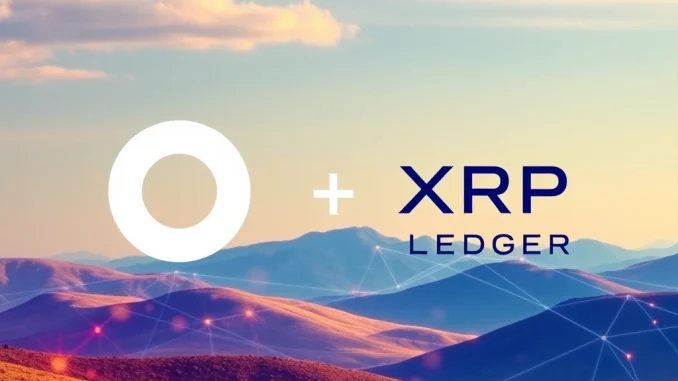
The digital asset world just witnessed a significant development. Circle, the issuer behind the widely-used USD Coin (USDC), officially announced the availability of its stablecoin on the XRP Ledger (XRPL). This integration is set to unlock new possibilities for users and developers alike, leveraging the unique capabilities of the XRPL network.
What Does USDC on XRPL Mean?
This announcement means that USDC is now natively supported on the XRP Ledger. Users can hold, send, and receive USDC directly on the XRPL, utilizing its infrastructure for transactions. This isn’t just a simple listing; it involves integrating the stablecoin into the core functions of the ledger, making it a first-class asset within the XRPL ecosystem.
Key aspects of this integration include:
- Native Support: USDC operates directly on the XRPL, not just via a bridge or wrapped asset.
- Accessibility: Users with XRPL wallets can manage their USDC alongside XRP and other assets.
- Developer Opportunities: Builders on XRPL can now incorporate a major stablecoin into their applications, including decentralized exchanges (DEXs), payment systems, and other DeFi protocols.
Why XRP Ledger USDC Matters?
The arrival of a major stablecoin like USDC on the XRPL is particularly impactful due to the ledger’s inherent strengths. The XRP Ledger is known for its speed, efficiency, and low transaction costs, making it an attractive platform for payments and asset transfers. Integrating USDC leverages these benefits:
For the XRP Ledger ecosystem, having XRP Ledger USDC brings several advantages:
- Increased Liquidity: A widely adopted stablecoin like USDC adds significant liquidity, particularly beneficial for the XRPL DEX.
- Enhanced Utility: Opens up new use cases beyond just XRP, making the ledger more versatile for mainstream financial applications.
- Developer Attraction: Provides a crucial building block for developers looking to create robust financial applications on XRPL.
- Network Effect: Connects the XRPL ecosystem to the broader network of users and applications already using USDC across other blockchains.
Circle Stablecoin: Expanding Its Reach
For Circle and USDC, adding support for the XRP Ledger is a strategic move that further expands the stablecoin’s presence across the blockchain landscape. Circle’s goal is to make USDC the most accessible and widely used dollar digital currency globally, and integration with high-throughput, low-cost networks like XRPL is key to achieving this.
Bringing the Circle stablecoin to XRPL contributes to Circle’s mission by:
- Widening Accessibility: Provides USDC users with another fast and affordable rail for moving value.
- Driving Adoption: Taps into the existing user base and developer community of the XRP Ledger.
- Strengthening Position: Reinforces USDC’s status as a leading stablecoin by being available on diverse and popular blockchain networks.
- Facilitating Interoperability: Although not a cross-chain bridge itself, expanding to more chains improves the overall potential for interoperability in the stablecoin space.
Real-World Use Cases for Crypto Payments on XRPL
The combination of a trusted stablecoin and the XRPL’s efficient infrastructure creates compelling opportunities for real-world applications, particularly in the realm of payments.
Potential use cases for making crypto payments with USDC on XRPL include:
- International Remittances: Sending money across borders quickly and cheaply, bypassing traditional costly systems.
- Micro-payments: Facilitating very small transactions that would be uneconomical on blockchains with higher fees.
- Business Settlements: Enabling businesses to settle transactions instantly and around the clock.
- Decentralized Trading: Providing a stable pair for trading other assets on the XRPL DEX without relying on volatile cryptocurrencies.
- Payroll and Gig Economy Payments: Paying employees or contractors efficiently using a stable digital dollar.
Navigating the Blockchain Integration Landscape
While the integration is a positive step, it’s important to consider the broader landscape and potential challenges. The success of blockchain integration like this depends on several factors:
- Wallet and Exchange Support: Users need their preferred wallets and exchanges to support the XRPL version of USDC for seamless access.
- User Education: Ensuring users understand how to use USDC on XRPL and the specific addresses/tags required.
- Competition: Other stablecoins and payment solutions exist, both within crypto and traditional finance.
- Regulatory Environment: The evolving regulatory landscape for stablecoins and crypto assets can impact adoption and usage.
Circle’s announcement, initially shared via their official X (formerly Twitter) account, signifies that the technical groundwork is complete, but ecosystem adoption will be a gradual process.
Actionable Insights: What Should You Do?
For those interested in leveraging this new integration:
- Users: Check if your preferred crypto wallet or exchange supports depositing, withdrawing, and holding USDC on the XRP Ledger. Look for official announcements from your service providers.
- Developers: Explore the XRPL documentation and Circle’s resources for integrating USDC into your applications built on the XRP Ledger.
- Enthusiasts: Keep an eye on the XRPL ecosystem for new applications and services that emerge, utilizing the newly available USDC liquidity.
In conclusion, the arrival of Circle’s USDC on the XRP Ledger is a powerful development. It combines the stability of a leading digital dollar with the speed and efficiency of a network designed for payments. This blockchain integration holds the potential to significantly enhance the utility of the XRPL ecosystem and drive wider adoption of stablecoins for practical, everyday transactions, truly revolutionizing how value moves in the digital age.



